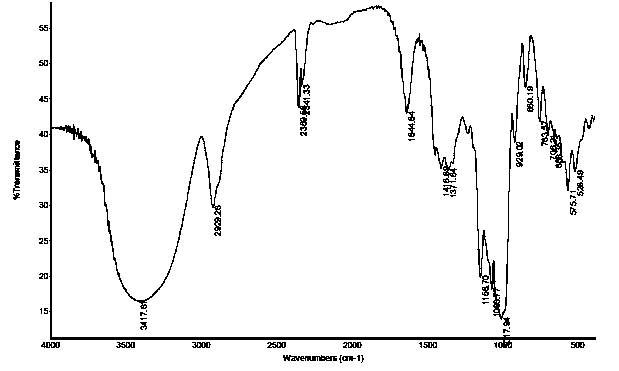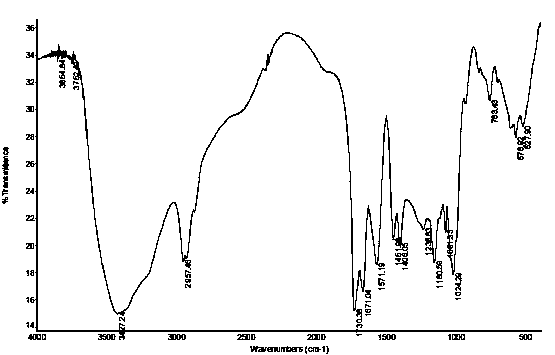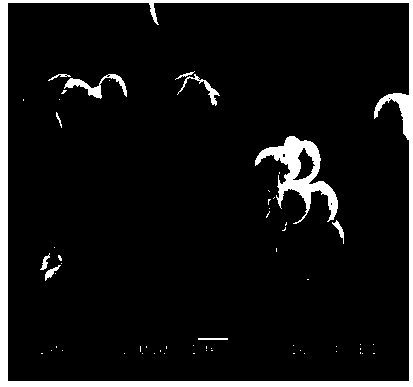Preparation method of cassava starch type high-water absorbency and oil-oil absorbency resin by cross-linked grafting technology
A technology of cassava starch and cross-linking grafting, which is applied in the field of preparation of cross-linking and grafting tapioca starch-type superabsorbent and oil-absorbing resins, can solve problems such as not being able to meet actual needs, achieve improved water-absorbing capacity and oil-absorbing capacity, and strong water-retaining performance and the effect of oil retention performance
- Summary
- Abstract
- Description
- Claims
- Application Information
AI Technical Summary
Problems solved by technology
Method used
Image
Examples
Embodiment 1
[0037] (1) Dry 15 g of tapioca starch in a vacuum oven at 60°C to constant weight to obtain tapioca starch on a dry basis.
[0038] (2) Weigh 12g of dry base tapioca starch obtained in step (1) and 28mL of deionized water into a four-neck flask, start to heat up while stirring, stop heating when the temperature rises to 80°C, continue stirring for 20 minutes, and then start to cool down. Until the system temperature is 40°C, a gelatinized tapioca starch suspension with a mass fraction of 30% is obtained.
[0039] (3) Add 15g of solid sodium hydroxide and 35mL of deionized water into a 100mL beaker, stir and dissolve to obtain a 30% sodium hydroxide solution.
[0040] (4) Measure 11 mL of analytically pure acrylic acid and pour it into a beaker, gradually add the sodium hydroxide solution obtained in step (3) dropwise under stirring until the pH of the acrylic acid solution is 6; then add 15 mL of acrylamide with a mass fraction of 50% solution, stir well.
[0041] (5) Evenly...
Embodiment 2
[0048] (1) Dry 20 g of tapioca starch in a vacuum oven at 60°C to constant weight to obtain tapioca starch on a dry basis.
[0049] (2) Weigh 15g of dry base tapioca starch obtained in step (1) and 30mL of deionized water into a four-neck flask, start to heat up while stirring, stop heating when the temperature rises to 85°C, continue stirring for 30 minutes, and then start to cool down. Until the system temperature is 60°C, a gelatinized tapioca starch suspension with a mass fraction of 33.33% is obtained.
[0050] (3) Add 20g of solid sodium hydroxide and 30mL of deionized water into a 100mL beaker, stir and dissolve to obtain a sodium hydroxide solution with a mass fraction of 40%.
[0051] (4) Measure 12 mL of analytically pure acrylic acid and pour it into a beaker, gradually add the sodium hydroxide solution obtained in step (3) dropwise under stirring until the pH of the acrylic acid solution is 7; then add 20 mL of acrylamide with a mass fraction of 50% solution, stir w...
PUM
| Property | Measurement | Unit |
|---|---|---|
| water absorption | aaaaa | aaaaa |
| oil absorption | aaaaa | aaaaa |
| water absorption | aaaaa | aaaaa |
Abstract
Description
Claims
Application Information
 Login to View More
Login to View More - R&D
- Intellectual Property
- Life Sciences
- Materials
- Tech Scout
- Unparalleled Data Quality
- Higher Quality Content
- 60% Fewer Hallucinations
Browse by: Latest US Patents, China's latest patents, Technical Efficacy Thesaurus, Application Domain, Technology Topic, Popular Technical Reports.
© 2025 PatSnap. All rights reserved.Legal|Privacy policy|Modern Slavery Act Transparency Statement|Sitemap|About US| Contact US: help@patsnap.com



